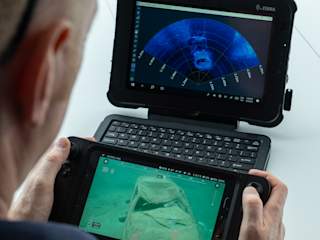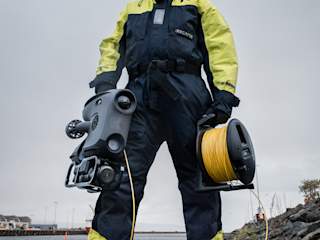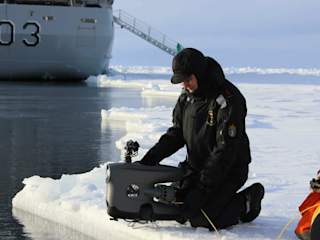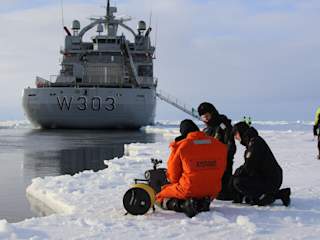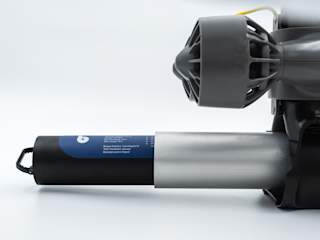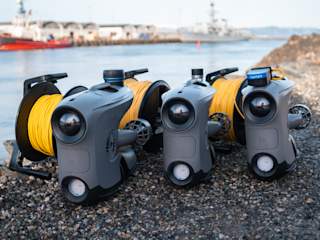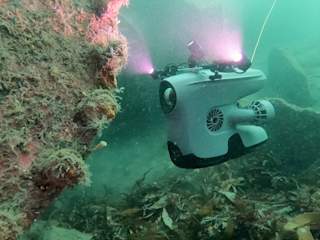Providing easy access to the ocean – for everyone
Blueye Robotics is a Norwegian underwater tech company established in 2015. Our roots are from the Norwegian University of Science and Technology (NTNU) and SINTEF Ocean. Today we are 18 full-time employees specializing in industrial design, electronics, software, robotics, business development, and marketing.
Initially developed for a consumer market, our founding principles have been applied to the commercial market, providing professionals with robust and user-friendly tools.
The basic system – how it's all connected
Before getting into the nitty-gritty of the Blueye design, it's necessary to get an overview of what the ROV system consists of and how it works.

The system is comprised of the ROV, a tether connected to the surface, and a control device running the Blueye App. The Blueye App provides a stable connection to the live camera feed the ROV controls, and sensor data collected during the dive.
The Blueye system may seem like that of other underwater ROVs, with hardware and software working together, but there are crucial differences that we will explore next.
"Feet down, head up and eyes forward" - explaining the ROV design choices
The three Blueye ROV models, Pioneer, Pro, and X3, all have the same form factor and are built on the same design principles. The Pioneer was the first model launched back in 2019, but years of R&D were completed before it was handed to our first clients.
The shape of the Blueye ROVs is a-typical for ROVs. Usually, ROV systems are box-shaped or more oval or round. The Blueye ROV resembles more of a large fish, and there are some major design choices behind that.
Hydrodynamic and self-stabilizing
The camera of the Blueye ROV is located at the top, and the heavier parts, such as the aluminum battery tube, are located at the bottom. Our technology works like the human body - our heads are on top, our eyes are looking forward, and our feet are on the ground.
The ROV has four thrusters, two carefully placed in the center and the other two at the back, keeping a significant separation between the center of buoyancy (COB) and the center of gravity (COG). A decision to keep the cost down led us to stay with four thrusters, and being very exact on the placement of these, we ended up with a self-stabilizing ROV design without the need for "pitch and roll" functions.

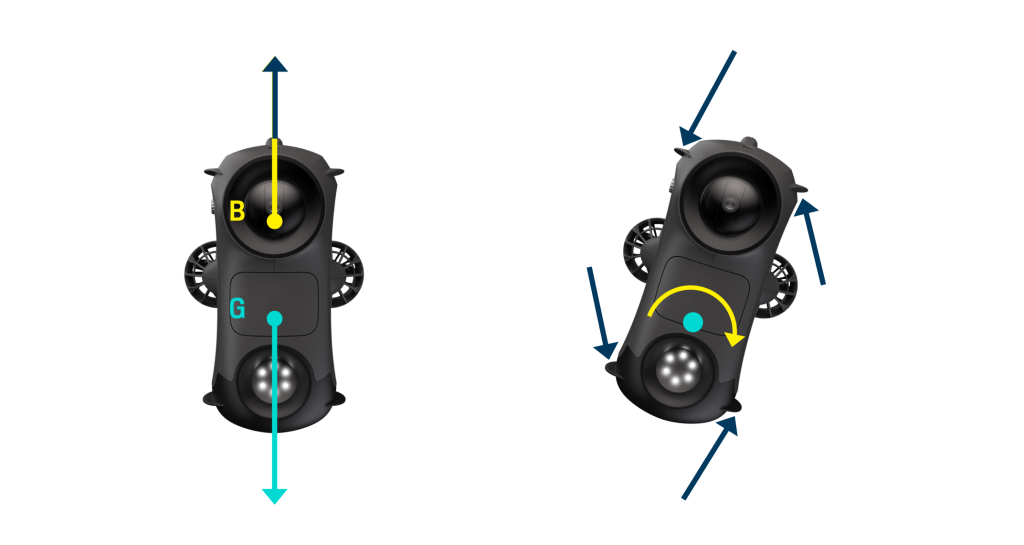
It's a lot easier for the operator to relate to the environment around the ROV when you know the camera and the ROV is always in an upright position.
- Rune Hansen, Lead Mechanical Engineer at Blueye Robotics
Another small but significant detail about the design are the "fins" located on both sides of the ROV. Without these "fins", maneuvering the ROV upwards and downwards in the water column had the ROV "wobbling" from side to side. After several iterations to find the correct shape and angle, adding these "fins" to the ROV compensated for this unwanted effect, letting the ROV thrust up and down to the seafloor in a straight line.
Another detail to mention is the choice to have removable batteries for minimal downtime. It enables the use of a thin and flexible tether which minimizes the drag from the water while diving. The connector point for the tether inside the ROV is not a coincidence either, as it's carefully planned for and placed in the center, and not at the back of the ROV, also to reduce the drag while diving.
The Blueye Smart Connector – converting advanced sensors to plug-and-play systems
Integrating 3rd party technology and tools into our platform is enabled via a Blueye Smart Connector. There is no need to download drivers, update the ROV, or to send the ROV back to the factory to simply add an accessory. Just like your computer detects and operates USB connected devices, the Blueye ROV automatically knows what is connected because the Blueye Smart Connector houses a small circuit board, including metadata.
It's all about making advanced tech easy to use and removing the manual configurations that complicate the setup.
- Jonas Follesø, Chief Technology Officer at Blueye Robotics

The metadata allows the Blueye ROV operating system (Blunux) to start the software modules needed to support a particular peripheral based on the connector information without any configuration required by the end user. On other systems, ROV operators would typically have to configure COM ports manually, set static IP addresses, and install system drivers to enable a new third-party peripheral.
The Gamma Ray "sniffer" and Oculus Multibeam sonars
We recently delivered a Blueye X3 model integrated with a Medusa Gamma Ray detector to the International Atomic Energy Agency (IAEA). The IAEA is tasked with measuring the levels of radioactivity spilled from the X-press Peal ship that took fire and sank in Indonesia in 2021.
Integrating the Medusa sensor into the Blueye X3 enables the IAEA team to read radiation levels directly in the Blueye App while diving. There is no need for external software as the readings are easily recorded with the Blueye App.

The Norwegian Coast Guard decided to equip their whole fleet of vessels with the Blueye X3 during the fall of 2022. Since receiving the ROVs, the Coast Guard has reported several successful search and recovery missions. The primary sensor for this delivery was the Oculus M750d multibeam sonar.
These underwater ROVs can dive to greater depths than the Coast Guard's own divers and can reach longer distances faster. This expands the Coast Guard's operational radius and increases efficiency in the execution of the Coast Guard's many tasks.
- Torill Herland, Commanding Captain and Communications Officer, Royal Norwegian Navy

App-software and off-the-shelf, well-established technology
The Blueye App connects the ROV, Surface Unit, and Controller together so the operator can pilot the ROV. Inspired by aerial drones, it was clear from the start that the Blueye ROV should be operated in the same simple and proven manner.
It's not just the flexibility of the app technology that led us down this path. It's equally important that the mental image the first-time-user develops in her mind is that this piece of equipment looks familiar and easy to handle.
- Jonas Follesø, Chief Technology Officer at Blueye Robotics
Another benefit of integrating apps is being part of a large ecosystem of apps. Integrating our apps with 3-party apps is easier, and the data flows much smoother. When COVID-19 closed down the world, we connected to Microsoft Teams in a few days – enabling remote inspections and digital demonstrations for clients.
The Xbox controller
Even though we do want users of the Blueye to recognize the tech instantly, we're typically also confronted with comments that the system looks like "a toy".
The standard controller offered with the system is an Xbox controller. We could have developed our own controller, but that would have made the system more expensive and less flexible for the user. If the controller gets broken, it's easy to buy a new one at the local electrical shop. The same applies to the devices running the Blueye App - you can choose your smart device of choice and upgrade whenever you want. Also, reflecting on the amount of R&D hours that have already been put into off-the-shelf gaming controllers, we decided that it's not worth customizing something that is already very applicable to our system. If it's good enough for the millions of gamers out there already being very picky about their gear, it's good enough for Blueye.

